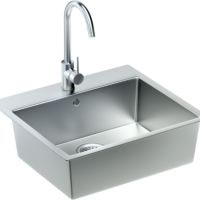
How do you clean an epoxy sink. Epoxy sinl realm of interior design and home renovations, finding the perfect balance between aesthetics and functionality is a constant pursuit.
Crafted from a blend of epoxy resins and natural stone aggregates, these sinks possess a unique allure that effortlessly elevates any space they grace.
Whether you’re aiming for a sleek and minimalist design or a bold and artistic statement, epoxy sinks provide endless possibilities for customization.
One of the most captivating aspects of epoxy sinks lies in their ability to mimic the natural beauty of materials such as marble, granite, or quartz, while offering increased resilience and longevity.
With their smooth, seamless surfaces, these sinks not only enhance the visual appeal of a room but also facilitate easy maintenance, making them an ideal choice for busy households.
Their non-porous nature ensures that liquids and substances are unable to penetrate the surface, preventing the growth of bacteria and making cleaning a breeze.
This feature also contributes to the longevity of epoxy sinks, ensuring they retain their pristine appearance for years to come.
Join us as we delve into the world of epoxy sinks, exploring their versatility, design options, and the many advantages they bring to your home.
From contemporary kitchens to luxurious bathrooms, epoxy sinks are revolutionizing the way we think about sink design, offering a harmonious fusion of beauty and practicality.
How do you clean an epoxy sink
This comprehensive guide will walk you through the process of epoxy sink installation and provide maintenance tips to ensure your sink remains in optimal condition for years to come.How do you clean an epoxy sink.
Understanding Epoxy Sinks
What is Epoxy?
Epoxy is a synthetic resin that, when combined with a hardener, creates a durable and chemically resistant material. It is commonly used in various applications, including countertop and sink installations.
Benefits of Epoxy Sinks
Epoxy sinks offer several advantages, such as
- Exceptional durability and resistance to chemicals, stains, and heat.
- Customizable designs and colors.
- Seamless integration with countertops, creating a visually appealing and hygienic surface.
- Easy maintenance and cleaning.
Types of Epoxy Sinks
There are two primary types of epoxy sinks
Molded Epoxy Sinks
These sinks are pre-fabricated and typically come in standard shapes and sizes.
Custom Epoxy Sinks
These sinks are custom-made to fit specific design requirements and can be created in various shapes and sizes.
Preparing for Installation
Assessing the Space: Measure the available space for your new epoxy sink to ensure proper fit and compatibility with your existing plumbing setup.
Gathering Tools and Materials
You will need the following tools and materials
- Safety goggles and glove
- Measuring tape and level
- Plywood or melamine boards
- Silicone caulk
- Mixing containers and stir sticks
Ensuring Proper Ventilation
Epoxy emits fumes during the curing process, so it is crucial to work in a well-ventilated area. Open windows, use fans, and consider wearing a respirator mask if necessary.
Safety Precautions
Always follow safety guidelines and instructions provided by the epoxy manufacturer. Wear protective gear, such as goggles and gloves, and keep the work area clean and organized to minimize accidents.
Epoxy Sink Installation Steps
Removing the Existing Sink
Turn off the water supply and disconnect the plumbing connections. Use a utility knife or putty knife to loosen any adhesive or caulk holding the sink in place. Gently lift and remove the sink.
Preparing the Surface
Clean the countertop thoroughly, removing any debris, grease, or caulk residue. Ensure the surface is level and repair any cracks or damage before proceeding.
Creating the Sink Mold
Measure and cut plywood or melamine boards to create the sink mold. Use silicone caulk to seal the seams and corners, preventing epoxy leakage.
Ensure the mold is level and securely attached to the countertop.
Mixing and Applying Epoxy
Follow the epoxy manufacturer’s instructions to mix the resin and hardener in the correct ratio. If desired, add pigments or dyes to achieve the desired color.
Pour the epoxy mixture into the mold, ensuring even distribution and avoiding air bubbles.
Curing and Finishing the Sink
Allow the epoxy to cure as per the manufacturer’s instructions. Once cured, remove the mold carefully. Sand the edges of the sink to create a smooth finish.
Polish the surface using polishing compounds and pads to achieve a glossy shine.
Epoxy Sink Maintenance Tips
Cleaning and Stain Removal
Clean your epoxy sink regularly using mild soap and warm water. Avoid abrasive cleaners or scrubbing pads that can damage the surface. For stubborn stains, use a non-abrasive cleaner specifically formulated for epoxy surfaces.
Preventing Damage and Scratches
Avoid cutting directly on the sink surface and use cutting boards instead. Place rubber mats or protective pads at the bottom of the sink to prevent scratching from heavy cookware or utensils.
Maintaining the Shine
Periodically apply a coat of epoxy-specific wax or polish to maintain the sink’s shine. Follow the manufacturer’s instructions for application and frequency.
Handling Hot Objects
Epoxy sinks can withstand high temperatures, but it is best to use trivets or hot pads when placing hot pots, pans, or dishes directly on the surface. Extreme and prolonged heat exposure may cause damage.
Repairing Minor Damage
In case of minor scratches or chips, sand the affected area gently and apply a layer of epoxy resin. Follow the curing and finishing steps mentioned earlier to ensure a seamless repair.
Troubleshooting Common Issues
Bubbles and Air Pockets
To prevent bubbles, mix the epoxy slowly and avoid vigorous stirring. If bubbles occur, use a heat gun or torch to remove them by gently waving the flame over the surface.
Uneven Surfaces
Ensure the sink mold is level before pouring the epoxy mixture. If the sink surface ends up uneven, sand it down gently and polish to achieve a smooth finish.
Color Fading or Discoloration
Over time, exposure to UV light can cause color fading or discoloration. Consider using UV-stable epoxy or installing window coverings to minimize direct sunlight exposure.
Conclusion
By following this comprehensive guide, you can confidently install and maintain an epoxy sink that adds beauty, durability, and functionality to your kitchen or bathroom.
Remember to prioritize safety, carefully follow instructions, and enjoy the benefits of your stunning epoxy sink for years to come.



